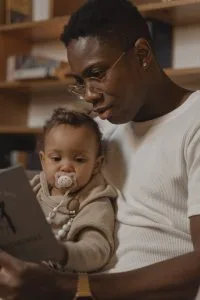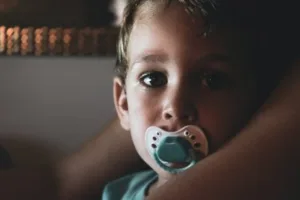 Most babies are born with a strong sucking reflex. Some even begin sucking on their fingers and thumbs before they are born.
Most babies are born with a strong sucking reflex. Some even begin sucking on their fingers and thumbs before they are born.
For babies, sucking is vital to getting nutrition, and it’s also a soothing behavior. Even more important, the American Academy of Pediatrics (AAP) recommends the use of a pacifier under certain conditions to help reduce the risk of sudden infant death syndrome (SIDS).
Parents often begin using a pacifier for its calming effects. However, the process of pacifier weaning is different for every child. Some children can give it up easily when their needs for non-nutritive sucking begin to wane, while others become dependent on their pacifier as a source of comfort.
For parents who are wondering when to get rid of pacifiers, there are several tips and factors to consider. Read on to learn more!
Why Toddlers Become Attached to Pacifiers
Toddlers become attached to a number of comfort items. A favorite toy or blanket can become a young child’s go-to item in any moment of uncertainty.
Similarly, a pacifier may remain a source of solace long after it has fulfilled its physical purpose. Using a binky, or pacifier, is a coping mechanism, much like how scrolling through photos on social media can be a stress-relieving coping mechanism for adults. A toddler/pacifier bond is especially difficult to break if the child uses the pacifier as a sleep aid.
Pacifier Pros and Cons
Concerns about pacifier use affecting a child’s dental health are valid, but a pacifier for 2-year-old children and younger is considered safe. Some of the benefits of pacifier use include:
- Stress relief for the baby and reduced crying
- Faster weight gain and fewer health problems overall for preemies
- Improved function of oral muscles
- A 90% less risk of SIDS for babies who sleep with a binky
While pacifier use comes with notable benefits, there are some drawbacks to consider as well. Some of the cons associated with pacifier use include:
- Increased risk of ear infection
- Potential dental problems
- May encourage early breast weaning
To help avoid the potential problems of pacifier use, wait until four to six weeks after birth to introduce a pacifier. This window provides enough time for a new mother’s milk supply to establish and for the infant to become confident in sucking either by bottle or breast.
When to Stop Pacifier Use
In light of possible dental problems, when should babies stop using pacifiers? Continued use very far past the age of three increases the risk of crossbite and protruding front teeth. Even damage to permanent teeth is possible.
There is no exact deadline for when to get rid of pacifiers. Most experts recommend pacifier weaning between the ages of two and four. Fortunately, children begin developing new stress-management strategies around two years of age. Getting rid of pacifiers is easier when a toddler has the developmental capacity to cope with stress in other ways.
Many developmental leaps happen around the age of three. It may be helpful to delay pacifier weaning until other milestones have been met. Weaning from the breast or bottle, potty training, and preparing for daycare are stressful experiences that can be more difficult for a child to navigate without the comfort of a binky to depend on.
If your child is especially distressed by these other changes in their life, waiting for them to self-wean may be preferable.
Tips for How to Get Rid of Pacifiers
 Once you’ve decided it’s time to start getting rid of a pacifier, you will then need to choose a method that best suits you and your child. There are two main approaches to weaning: fast or gradual.
Once you’ve decided it’s time to start getting rid of a pacifier, you will then need to choose a method that best suits you and your child. There are two main approaches to weaning: fast or gradual.
Fast Weaning
A fast approach may reduce the stress and anxiety related to weaning.
Start by explaining to your child that it’s time to stop using the pacifier. Assure them they are big enough to give up the habit and that everything will be okay. Let them know the timeline, as in, “Tomorrow, we will take all the binkies out of the house.”
Talk about other toys or objects that could be used for comfort instead. Help your toddler decide which teddy bear, blanket, or other item will replace their pacifier. You might also consider buying a special new toy for the job.
On the designated day, remove all pacifiers from the house. To reduce stress, you may want to complete this job while your child is asleep. However, if they are feeling positive about the decision, you could have them help you collect all the pacifiers and throw them away.
Be prepared for a day or two of tears, especially at any peak times for pacifier use, such as bedtime and naptime. Stay strong in your decision. Try to distract your child when they get upset. Remind them about using their new object for comfort instead. In most cases, the child will move on in two or three days.
Slow Weaning
Many parents wonder how to break pacifier habits in a gentle way. Following a slower route that includes limiting pacifier use may be preferable for some families. For this method, start by talking with your toddler about being old enough to let go of their binky.
Give them new tools for coping with stress. When they feel the need for comfort, hand them one of the new items instead of the pacifier. And when they successfully occupy themselves with the new object, shower on the praise.
Once your toddler has become more accustomed to the new soothing item, limit their use of any pacifiers. Their reaction toward limits will help you understand when to get rid of pacifiers completely.
Use your instincts to choose a block of time that would be easiest for your toddler to be successful with weaning. Eventually, limit pacifier use to bedtimes and nap times; once those limits are successfully managed, work on reducing use at those times as well.
The gradual method requires a balance of choices and rewards. Choices like, “If you want to use your binky right now, you have to stay in your room with it,” give the child some power in the matter and help them feel more in control.
Don’t hesitate to reward your child at every opportunity. Sticker charts, verbal praise, and rewards of the child’s choice will help to reinforce how proud you are of your child’s accomplishment.
How Can an Au Pair Help Break the Pacifier Habit?
Knowing when to get rid of pacifiers can be a difficult decision, but you don’t have to tackle it alone.
An au pair is your parenting assistant. Your au pair can be a great source of additional comfort and confidence for your child once you’ve decided when to stop pacifier use. While an au pair brings training and experience to each family, their role is to support parents and follow their child-rearing guidelines.
By partnering with an experienced au pair and keeping these tips in mind, you and your child can successfully break the pacifier habit. Find an au pair today!


